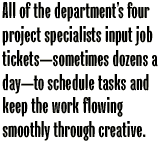
|

|
"I can show managers how long a job takes and what it takes to finish it," Roger
says.
He also developed a Clients & Profits
workflow chart. From this template, the department can easily
plug in start and due dates, milestone dates, and other key
information. "We hand it to the manager so they know exactly
where their job will be as specific times," Roger says.
Currently, the creative services
division is the heaviest user of Clients & Profits. "We're
rolling it into the other departments," Roger explains. For
example, the company's video department uses scheduling and
job tickets, but depends on creative services to do the data
entry. "We'll set them up as a cost center and bring them up
to speed over the next year," Roger says. "Then they can do
their own work."
Implementing controls
Keeping on top of about 200 active
jobs at a time is no small feat. "My day starts with a production
meeting first thing in the morning," Roger says, "then we have
another short, informal one before we go home to check up on
the day's progress." Production reports generated from Clients & Profits,
along with automatic email sent when job status codes change,
simplifies the process significantly. But some really big,
complex jobs are supplemented with two magnetic job boards. "We
use colored magnets to mark days and status codes so everyone
can see right where a job is," Roger says. "We run all kinds
of jobs through C&P," Roger says. The department produces
a variety of collateral such as hats, logos, pens, banners,
balloons, posters, and in-store displays for dish distributors.
Additionally, EchoStar produces in-house video specials, commercials,
and other broadcast media.
Pinpointing artists' downtime
All of the department's four
project specialists input job tickets -- sometimes dozens a
day -- to schedule tasks and keep the work flowing smoothly
through creative. "They deserve major kudos for all their work
on the front line," Roger says. With the four specialists staying
on top of the work-to-do, the department is able to maintain
a good and accurate schedule. Now, the communications department
can pinpoint downtime for the artists, which lets them "plug
in" small jobs. "Some of the smaller, quick-turn jobs aren't
scheduled," Roger says. "It would take more time to do that
than to finish the job."
One of the first things Roger
did when he came on board was check out the built-in reports
in Clients & Profits.
|
Not only does he run several workflow reports, he also dug
into financial analysis. ("I had just finished my MBA," Roger explains, "and
looking at the numbers just came naturally.")
One of the managers wanted a
little more information about a certain job, so Roger ran a
couple of reports from Clients & Profits. They discovered
that there were 150 hours logged to the job, but no work had
been produced! "Management was floored," he said. Another unpleasant
surprise showed 47 hours of time logged to a job that was canceled.
By analyzing these reports, EchoStar
can see howmuch we're spending and why. "It's really helped
us take control and educate the other departments about what
we can and can't do."
Motivating the crew
Although there was some initial
resistance to the new use of Clients & Profits, the breakthrough
occurred after the company demonstrated the vision of the corporate
communications department. By showing them where the department
is going, a lot of resistance to the new system evaporated. "Once
they saw the reports from Clients & Profits, they were
more okay with adapting to Clients & Profits," Roger says.
(Not to mention that the word came down that anyone who didn't
want to use it could look at the classifieds.) "Folks got motivated
to take 20 minutes to add their time," he says.
Since the project specialists
(the folks who make sure the jobs get done) were used to entering
data in to Clients & Profits, the greatest resistance was
adapting to creating schedules. But once they realized the
value of scheduling and data tracking they grew to depend on
it. "Now, if we have a power failure or tornado or something
that pulls the system down, we can't be without it," Roger
says.
Blazing a trail in satellite
TV
EchoStar Communications Corp.
was founded in 1980 by Charlie Ergen, his wife Cindy, and James
DeFranco. Over the past two decades, the company has been blazing
a trail in satellite television. Noted for an impressive list
of industry "firsts," EchoStar recently won the "Best of What's
New" award from Popular Science for developing in cooperation
with WebTV Networks, Inc. the DISHPlayer, the world's first
interactive satellite TV receiver.
EchoStar is traded on NASDAQ
as DISH and DISHP, and was ranked 551 by Fortune Magazine in
2001. The company is the twentieth largest media company in
the world, ranked by Ad Age, and second only to DirecTV in
its media sector.

|

|

|

